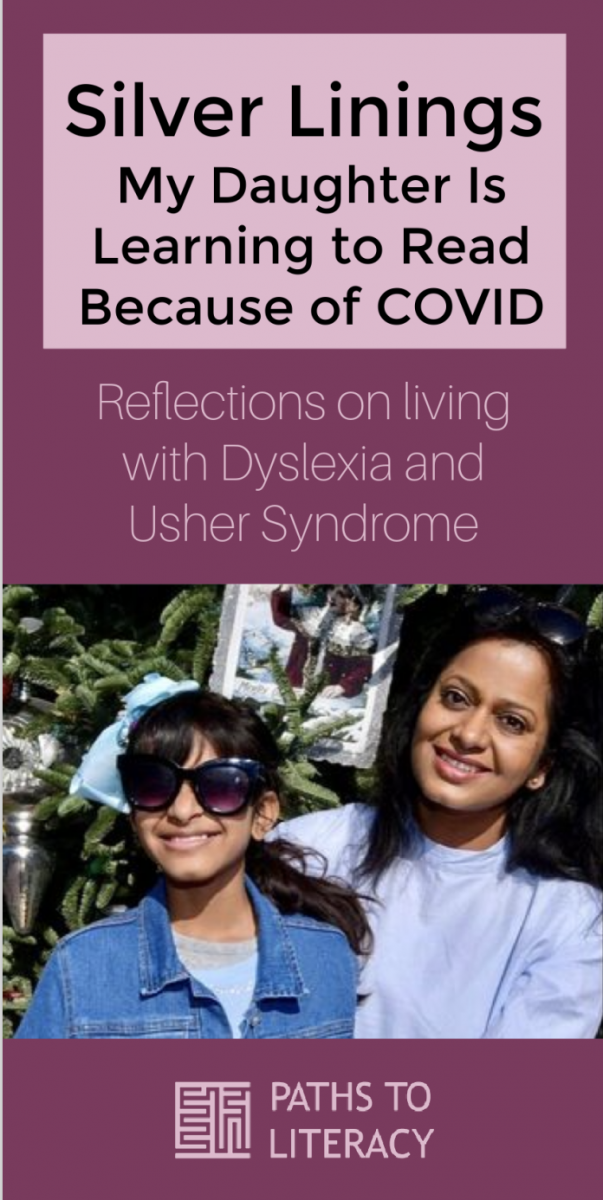Silver Linings: My Daughter Is Learning to Read Because of COVID
When remote learning started, post spring break in the 2020 COVID world, I was suddenly given a front row seat to my daughter’s academic life, a rare departure from our life before. By way of background, my daughter is 11 years old and is in the 5th grade. She is deafblind due to Usher Syndrome Type 3B and I was determined that I wouldn’t let COVID cause her academic skills to regress. I was enthusiastic to support our beloved teachers who suddenly had to migrate their lesson plans to the digital world. I volunteered my time to support her as her deafblind intervener to help her access her lessons.

From the very first day, I noticed that, irrespective of the time we started to work, if she struggled with reading, she would say, “I’m having a bad vision day,” or “my eyes are just tired”. It did not add up to me because I knew that her eyes were not tired.
"My Brain Is Tired!"
Why Is My Daughter Struggling with Reading?
That innocent dialogue was a revelation. How simple were her answers to my questions! And how exactly well defined were her needs! I could not believe that it took COVID for us to finally understand - why is she struggling with reading?
Our girl is a medically complex child, who is also a child with deafblindness, and as such, the answers are never easy. Throughout her education, no one had an explanation for why she was not able to learn to read, we were only offered assumptions that maybe it’s because of her hearing, or maybe it’s because of her vision, or maybe a combination of both. A learning media assessment showed that she was a visual learner and needed modifications of large fonts/prints, so we tried that. But when we did not see her gaining reading skills, we started exploring other ways. We explored braille and found that her struggle to learn to read remained. She was struggling both in print and braille. Neuropsychological evaluation showed that she was in the average IQ range so there was no possible cognitive reason for her to struggle in learning to read. So, given the lack of medical and psychological abnormalities beyond her deafblindness, the professionals fell back on platitudes; every child develops at their own pace; or, she’s a child who cannot see well, you must know that she may never learn to read like her peers.
Embracing the Science of Reading Approach
Being a mother of a complex child does not come with a handbook. I lacked knowledge of her disability and for years trusted professionals rather than our own gut feelings. I was given the impression that her difficulties with reading were consistent with issues faced by other deafblind children. I did not understand how a learning disability presents itself, and that she is one of those students that would not learn to read using the "balanced literacy" approach or 3 cues. She needed the pattern and structure of the "science of reading" approach.
This void in my understanding changed when she answered my questions and I viewed them through the lens of my uninterrupted observations. Thanks to the remote learning platform, I could access her curriculum, utilize various learning apps on her school webdesk to identify her skill gaps and areas of needs, and create a working plan to help her improve her reading skills.
Then I began trying to teach her to read. I started by showing her common sight words.
Her questions were valid and logical and I didn’t have an answer. As a mother who wants her child to always use her voice, to never take an explanation as "because I said so..", to continue to ask questions when things don’t make sense, I responded with, "Let’s become detectives, and look for ‘WHY?’"
Little did I know that this "why" would open the door to a lot of answers for me. Suddenly, I was learning about the rule for syllabication, the six syllable types, open vowel and closed vowel, word units, prefix, suffix, segmenting, decoding, blending. I was attending "how to teach reading workshops", and watching YouTube videos on techniques of decoding, or the science of reading to get an understanding of how our brain learns to read. I was talking with parents in the dyslexia world, and we were exchanging notes and being amazed with how similar our experiences and challenges have been.
The more I learned, the more I was able to share with my daughter, and the better she started to read. It was like a whole new world was opening for us both. This new world was the world of structured reading, based on the science of reading.
Gaining Confidence and Making Progress
As she started trying to read more she gained confidence. She knew I would find answers to her "why?". I started seeing patterns in her way of reading. I observed that she will add or omit sounds. While reading words, she will say individual letters correctly, but string them together wrong; and mostly use approximation/replacement with similar-looking, previously-read words in the absence of picture clues (see how this can confuse people into believing this a vision issue and not a reading strategy issue?). In the past, she was always encouraged to look at pictures (up to 4th grade, she could only check out picture books from the school library). Unbeknownst to me at the time, this conformed with the three cues method of teaching reading, consistent with the "balanced literacy approach". So it was new to her when I started telling her, "Slow down, miss. Look what you are reading!" I would tell her, "Let’s go back and sound out the word again, one letter at a time. Let’s use the patterns we know. Is that an open syllable or closed syllable?"
And boom! She started auto-correcting herself. If there was any doubt in believing that her reading difficulties were not caused by her vision but lack of appropriate reading techniques, this was irrefutable proof that she could read; she just hadn’t been presented with a strategy that made sense to her.
When it came to spelling, I observed phonetic-based spelling patterns, consistent with innocent patterns that we see in every child that is learning to write. She would write words as she hears them: "does" will be spelled "dus", "what" as "wat", "rough" as "ruf", etc. The only thing not so innocent was that she was aware that she was not a kindergartener or first grader, and that many of her friends were reading and writing "fluently". I discovered this is why she would hesitate to write letters to others; she would never volunteer to read when we would go for Girl Scout events, or she would start by saying, "I am deafblind. I cannot read." This is why she would always tell me, "I will do online college, if I decide to do college. Studying is boring."
Recognizing Her Dyslexia and Learning Disability
There was a lot of learning happening for both of us. The biggest lessons for her was that her struggle with reading was not only because of her vision. In the past she did not know that she was experiencing a reading challenge, secondary to her vision. But she knew it now.
By the time the new academic school year started in the fall, she had gained two reading grade levels, as documented by a reading assessment test. Over the months, I had attended at least 70-80 hours of online reading lessons, workshops etc. I had connected with an army of dyslexia parent advocates who supported me and shared their own knowledge and experiences to drastically improve my learning curve. I could read IEP (Individualized Education Program) goals, and know if they were written with higher academic expectations or not. I could talk about phoneme-grapheme mapping; I could do phoneme-grapheme mapping. I understood the Orton-Gillingham method, Secret Stories method, etc. I learned Floss is not just a dance that children do but also F, L, S, and Z are the consonants that are doubled at the end of a word when they follow a short vowel sound. I know when a one word syllable has a k sound immediately after a short vowel, you spell it with "ck" like "luck", but if there is a consonant sound before the "k" sound and after the vowel, you use "k" like "dark". My army of advocates helped me find a tutor in faraway Canada who started working with my daughter in November. Today, we have received 5 classes from her and she is supporting both my daughter and me in our journey.
Due to COVID, I was given the opportunity to observe my daughter meaningfully; it allowed me to gain insight that led me to get the answers for her struggle. I'm thankful that we have found a way for her to learn to read (she chooses to be a print reader), and she knows that her reading challenges are separate from her vision. She is gradually gaining reading skills, but the gap between her skills and her grade level expectations is still very wide. I’m always aware that she is a child with dual sensory loss, and this reading need is separate from pre-teaching, post-teaching and comprehension checks that every deafblind proficient communicator needs. I’m aware that she fell through the cracks in the system because there’s not enough research on the unique educational needs of a deafblind child; that somehow when a deafblind student struggles to learn to read, we think braille will fix it. I’m aware that she will need more hand holding, but I am also aware of her strength and perseverance.
Our deafblind children have access to modern science and technology, and it’s changing the way we understand deafblindness. There’s no one set way to find the best education placement for them. We need a paradigm shift in our thinking.
KEY TAKEAWAYS FROM MY EXPERIENCE:
- Children who are deafblind have educational needs, similar to their gen-ed peers, and these are separate from their vision and hearing issues.
- Deafblindness is a spectrum. Each deafblind student has a unique set of learning needs. When we are designing their educational program, it’s important to design IEP keeping in mind that child’s expressed needs. IEP should always be child led.
- Dyslexia is not a vision issue, it is a reading issue. Braille readers also have dyslexia.
- Early identification of learning disabilities in deafblind students is critical.They already start with a dual sensory loss, and delay in identification is catastrophic for them.
- Sometimes, the right answer to solve problems is unconventional. We need to throw away our idea of what it should look like, and collaborate together by factoring in inputs from parents, educators, researchers and the child to design a novel education placement.
- Statistically speaking,1 in 5 students have some form of learning disability. The National Center on Deaf-Blindness survey shows that as of December 2020, there are about 10,500 deafblind children between the ages 3 - 21. 20% of them are in mainstream classrooms. When we fail to identify these kids, we are denying their right to Free Appropriate Public Education (FAPE).
- We need to reach out to more parents to find common identifiers, experiences and success stories. This knowledge will educate and better empower teachers and parents. This will significantly help deafblind students who are struggling with literacy.
- Professional development and training opportunities for school districts, teachers, staff, and parents are very important to ensure that each deafblind child in the mainstream classroom is given an appropriate educational opportunity with goals that are designed with highest academic expectations, keeping ESSA 2015 (Every Student Succeeds Act) at its core.
This article was reprinted with permission of the author.

